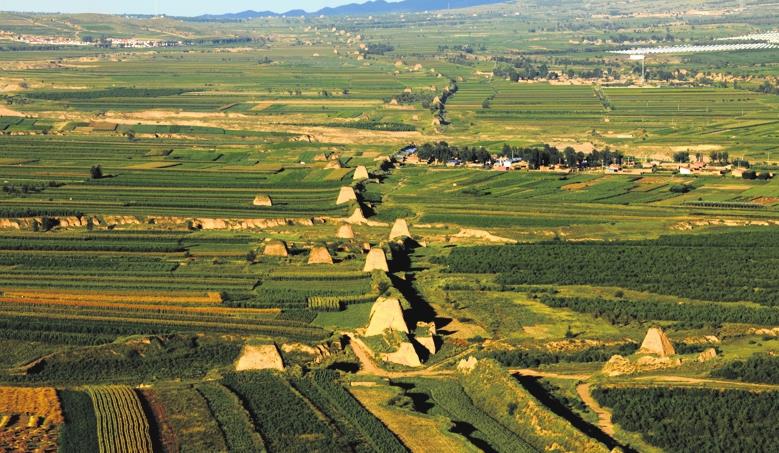


Various sections of the Great Wall in Shanxi province still stand as silent witnesses to a history of more than two millennia, although they are not as complete as they were in the past days. PHOTOS PROVIDED BY YANG JIANMIN

The Guangwu section of the Great Wall in Shanyin county is a complete defense system consisting of walls, watchtowers, fortresses and other facilities. YANG JIANMIN / FOR CHINA DAILY
Rome was not built in a day and neither was the Great Wall in China.
Historical records show that the Great Wall is the greatest defense project in China,built in a period spanning about two millennia from the Warring States period(475221 BC)to the Ming Dynasty(13681644).
Called“the Great Wall Museum”,Shanxi province is one of the best places to see the ancient wonder with characteristics of various periods.
With a total length of more than 3,500 kilometers in Shanxi,the Great Wall can be found in nine cities and about 40 counties.More than 1,500 km of walls and other relics are still kept relatively intact.
Yang Jianmin,a resident in Datong city,is a photographer and researcher of the Great Wall.
An explorer of the Great Wall for decades,Yang discovered in Shanxi relics of Great Wall sections built in the Warring States,Qin Dynasty(221207 BC),Northern Dynasties(386581),as well as Song(960 1279)and Ming dynasties.
“Seen from the maps of China,the Great Wall is basically a long line from Hebei province in the east to Gansu province in the west,”Yang said.“But in Shanxi,the Great Wall has many sections distributed in a broad area spreading about 800 km from north to south.”
The researcher said the Great Wall is a comprehensive defense system consisting of walls,fortresses and other military facilities.
Such a complete system can be found in the ancient town of Guangwu in Shanyin county.
The ancient town is composed of two villages—the Old Guangwu and the New Guangwu,which used to be two fortresses along the Great Wall built in the Ming Dynasty.There are no historical records showing when the ancient town was first built.
Archaeologists found a number of structural relics left by the Liao Dynasty(9071125)but they don’t believe the relics illustrate the town’s origins.The city wall,1,652 meters in length and 8.3 m in height,was built during the Ming Dynasty.
The residences inside the town are mostly houses in Ming Dynasty style.
Researchers believe the houses used to offer accommodation to the military forces in history.
Neighboring the ancient town is a 32squarekilometer site of about 300 Han Dynasty(202 BCAD 220)tombs.Researchers speculate the site was a burial ground for generals and soldiers who died in battles against the invaders about 2,000 years ago.
“When I was a child,I was told the ancient town and the Great Wall was built 1,000 years ago.But recent discoveries show the history of the relics should be at least 1,000 years older than that,”said Ma Yufang,Party secretary of the Old Guangwu village.
With more discoveries published in the media,Ma said the Great Wall,the ancient town and Han tombs have sparked great interest among both researchers and tourists.
“We receive hundreds of visitors every day,”Ma said.“Many of them are excited to be on this site to explore a storied history related to the Great Wall and related to the ancient frontier.”
The Great Wall is regarded as an important symbol of the nation.In ancient China,it was closely related to the fate of the nation.In times of peace,the Great Wall passes were venues of exchange between the Han people and nomads in the north.
When wars took place,the wall was pinned with high hopes in the defense against invaders.
And if the wall was captured by the enemies,it was always disastrous to the nation.
Because of its historical significance,the Great Wall is a mustsee attraction for domestic tourists.
Its importance is further enhanced by the famous quote of late Chinese leader Mao Zedong:“He who doesn’t reach the Great Wall is not a true man”.
Capitalizing on enthusiasm for the wall,many regions in Shanxi are using the historic relic as an opportu nity to boost local economic growth.
Datong city in northern Shanxi,for instance,boasts 263 km of Great Wall sections in its five counties and districts.
Wu Hongwen,mayor of Datong,said the city is promoting a Great Wall sightseeing route to tourists.
“Just like the famed Yungang Grottoes,one of the top three Buddhist grottoes in China,the Great Wall is likely to become another calling card of Datong’s tourism,”Wu said.
Weathered by the wind and rain in a period of millennia and challenged by the booming tourist rush in modern times,protecting the Great Wall has also become a pressing concern of the regions along the Great Wall.
Pianguan county in the northwest of Shanxi,for instance,has prioritized protecting its precious Great Wall resources,including 126 km of wall,36 fortresses and more than 300 watchtowers.
According to Wang Yuan,Party secretary of Pianguan,the county has invested more than 100 million yuan($14.13 million)in protecting the Great Wall during the past 10 years.
“Protection is the prerequisite for using the Great Wall as a resource for tourism development,”Wang said.
Li Yali contributed to this story.
By YUAN SHENGGAO
 山西路桥:党建引领 建好“四好农村路”山西路桥建设集团党委扎实开展“党建质量提升年”,实施“六大工程”,立足“十四五”高质量、高速度、高效益发展的战略基点,全面提高党建质量和党建引领发展水平,为打造“国内一流的交通基础设施投资、建设、施工现代化企业集团”提供坚强政治保障。
山西路桥:党建引领 建好“四好农村路”山西路桥建设集团党委扎实开展“党建质量提升年”,实施“六大工程”,立足“十四五”高质量、高速度、高效益发展的战略基点,全面提高党建质量和党建引领发展水平,为打造“国内一流的交通基础设施投资、建设、施工现代化企业集团”提供坚强政治保障。
 常住人口3491万 山西人口普查数据"出炉"山西省统计局向社会通报山西省第七次全国人口普查主要数据。数据显示,山西省常住人口为34915616人,比2010年(第六次全国人口普查数据,下同)减少2.23%,年平均减少0.23%。山西省常住人口总量减少,主要受人口流动变化等因素影响。
常住人口3491万 山西人口普查数据"出炉"山西省统计局向社会通报山西省第七次全国人口普查主要数据。数据显示,山西省常住人口为34915616人,比2010年(第六次全国人口普查数据,下同)减少2.23%,年平均减少0.23%。山西省常住人口总量减少,主要受人口流动变化等因素影响。